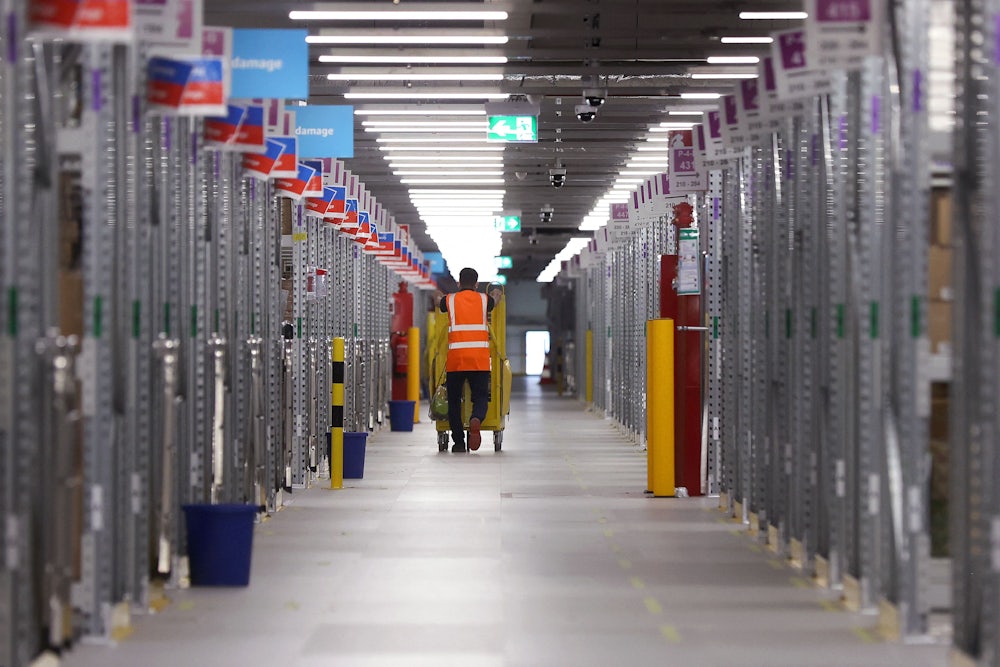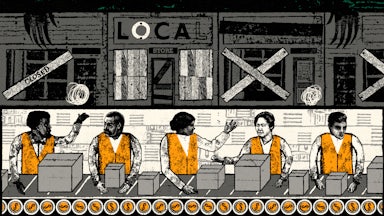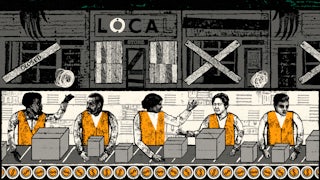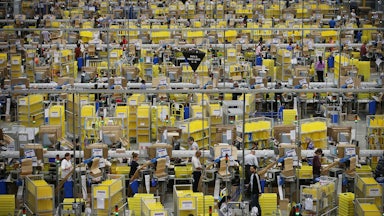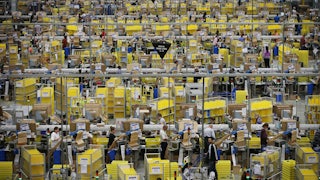Last week, beleaguered Amazon workers and organizers received a rare gift from the government—two, in fact. The National Labor Relations Board released a ruling stating that Amazon officials had unlawfully interfered with the union election at a warehouse in Bessemer, Alabama, and recommended that the election, which recorded 1,798 votes against unionization and 738 in favor, should be held again. A second NLRB ruling declared that Amazon had also unlawfully interfered in union organizing at a facility in Staten Island, where Amazon staff confiscated organizing literature from a worker.
Together the decisions represent solid (if inadequate) rebukes to Amazon’s cutthroat union-busting efforts, which have ranged from the expected—firing organizers, slandering workers in the press, distributing anti-union pamphlets and text messages, worker surveillance, implementing new work schedules that made on-the-job organizing more difficult—to the vaguely dystopian—tinkering with the timing of traffic lights near the Bessemer warehouse and convincing the U.S. Postal Service—with a great deal of coercion and influence, as subsequently released emails revealed—to install a mailbox on company premises, where ballot drops could be easily surveilled. If the decision is upheld by senior NLRB authorities, another election could come as soon as this fall. Organizers will have learned some lessons since then, but the danger is that Amazon leadership has, too.
The end of Amazon as we know it may not play out for several years—or may never come—but the early stages might be visible now, in Bessemer, Alabama, in union drives in New York, strikes at European warehouses, and grassroots community protests against new Amazon facilities. The Teamsters Union, one of the country’s largest, has promised to devote significant resources to what could be a generation-long effort to “build worker power at Amazon,” while organizing across the company’s vast archipelago of warehouses.
The effort to tame Amazon also goes far beyond labor unions. It involves antitrust regulators, Congress, and, increasingly, grassroots efforts by towns and cities that know that what happens at an Amazon facility has profound potential impacts on their communities—from pollution to tax breaks to health care to corporate power and political influence. With potential antitrust action in the offing—one of a half-dozen antitrust bills floating through Congress could lead to breakups for mega-tech companies like Amazon—and some energy behind organized labor and activists, there is a potential opening to imagine what a more humbled Amazon might be. Such an Amazon could be hard to recognize: It would be something far different from a $1.7 trillion company that dominates the market via a model of bottom-barrel labor costs and ultralow prices that gouge suppliers and force out competitors. (It’s a model that—along with workplace surveillance—Amazon has helped to spread through e-commerce and other industries.) What does Amazon look like in the event that labor and trustbusters win? The fate of Amazon augurs much more for the American economy than we might realize: It affects how we work, shop, and live, and it carries serious implications for hundreds of communities that play host to Amazon facilities and the people who labor there. And so the question stands: Can Amazon be tamed? Or is it beyond reform?
One crucial factor in Amazon’s growth has been its access to a seemingly bottomless pool of precarious labor. The company has shown a willingness to tolerate—and even encourage—an incredibly high rate of turnover for its warehouse workers. Among the causes, according to one report from the National Employment Law Project, are the productivity quotas required of workers: “Amazon workers around the country have reported being subject to unsustainably fast productivity requirements resulting in injury and exhaustion. Workers describe pushing their bodies to the brink to avoid automatic termination for missing quotas. Data from the company’s own records have confirmed their accounts showing that Amazon warehouses have stunningly high injury rates.” (A bill currently lingering in California’s state legislature, AB 701, would mandate that employers like Amazon be transparent about work quotas.)
Sudden injuries and rapid turnover are anticipated, built into the company’s employment structure. “Amazon relies on an extreme high-churn model, continually replacing workers in order to sustain dangerous and grueling work pace demands,” according to the NELP report. In counties where Amazon establishes fulfillment centers, warehouse worker turnover rates skyrocket. Another study found that turnover for Amazon warehouse workers nationwide was about 150 percent per year.
This heavy turnover model is by design. It makes it harder for workers, especially militant ones, to stick around and commit themselves to organizing. (It also has—perhaps unintended—effects that percolate into local communities, as people see their friends and family frequently fired by opaque algorithms or laid low by warehouse injuries.) Despite this churn, the pandemic has been a watershed in Amazon worker militancy, according to Sheheryar Kasooji, the executive director of the Warehouse Worker Resource Center. “Last year was kind of a defining moment,” he told me, “where all the things we knew about Amazon and other big global corporations were proven to be not just true but even more extreme than we thought, in terms of their ability to profit from other people’s suffering during a pandemic, in terms of being able to consolidate power.”
As a warehouse organizer, Kasooji speaks of basic needs like health, safety, and good wages. But he also talks about grassroots community efforts that may do as much as anything to shape how Amazon operates. He called California’s Inland Empire, where he lives and works and which is host to numerous distribution and warehouse facilities for many companies, “an industry region, not a company town.”
“Everybody knows that there’s a problem,” said Kasooji. “Everybody knows that Amazon is part of that problem. And it’s about saying, OK, what do we do about it?”
The answers range from small acts of quiet dissent—“workers resist in their workplaces every day,” said Kasooji—to supporting antitrust measures, to official labor organizing, to community-based political action. Randy Korgan, a Teamsters official, said that we have entered a new era of “mass exploitation,” one that recalls previous periods of labor unrest, such as during the Great Depression. About an NLRB election like the one in Bessemer, said Korgan, “That’s just one of many strategies to organize.” (Kasooji had a similar belief, saying: “I don’t personally think that NLRB elections are the path forward. But everybody has to be trying things.”)
Ellen Reese, a professor of sociology at University of California, Riverside, called it the “churn factor”: “They’re hired during the peak season, and at the end of the peak season they’re let go,” she said. “Those seasonal workers don’t have the same access to benefits as other workers, nor do the part-time workers.” Reese noted that Amazon at times even pays workers to quit, converts temporary workers to full-time, fires people for failing to meet quotas, or otherwise shuffles its workforce.
If organizing efforts succeed, they will have to disrupt the labor churn and thereby disrupt the business model. That would allow workers to stick around, organizing to grow in strength, and perhaps to achieve some victories in individual warehouses. A successfully negotiated collective contract at just one warehouse would offer an example—and organizing energy—to others. It would mean better wages, health and safety standards. Lesser churn, in other words, means more power for workers and a weakened Amazon that can no longer dominate the labor pool and the marketplace as it has to this point. It could also have profound trickle-down effects for Amazon’s suppliers and competitors.
Under existing circumstances, though, organizing one warehouse at a time “is a pretty daunting and perhaps impossible prospect,” said Stacy Mitchell, co-director at the Institute for Local Self-Reliance and co-founder of Athena, an umbrella group encompassing numerous grassroots organizations concerned about Amazon, labor, democracy, and other associated issues. “Workplace organizing has never been a sufficient strategy in the face of highly concentrated corporate power,” said Mitchell. “We lost track of that and have been imagining for decades now that unions could figure out the right angle,” in hopes of reigniting a 1950s-style labor movement.
For Mitchell, dispersing ownership and the “tools of economic power” are essential to tackling Amazon and what she calls the “huge threat this company poses to the economy and to people’s livelihoods, but also to democracy.” She thinks that, under proposed antitrust legislation, Amazon could be broken up into five or more companies. These might include a retailer, a logistics company, Amazon Web Services, an e-commerce platform for third-party merchants, a delivery service, and perhaps Amazon’s various other interests in anything from health care to video games to advertising. Once the company is divided into more manageable pieces, community organizers and unions and regulators will have a much easier time handling it—along with returning dynamism to a market atrophied by the presence of a few big monopolies. (Sheheryar Kasooji also spoke of the more democratic possibilities if Amazon, or parts of it, were converted to utilities or some form of public ownership.)
While there has been little movement toward turning Amazon, or part of it, into a publicly owned utility, the Biden administration has expressed significant support for the labor struggle. In March, speaking out against “anti-union propaganda,” Biden got behind the Bessemer union drive. Saying that it was his policy to support unions, Biden said, “There should be no intimidation, no coercion, no threats, no anti-union propaganda.” Anti-Amazon sentiments can be seen in other parts of the administration, including in the Federal Trade Commission, whose chair, former Columbia law professor Lina Khan, helped make her name with a paper that challenged Amazon on antitrust grounds. Her agency is likely to target Amazon in a major antitrust suit, which could lead to its eventual breakup.
Assume some part of this quixotic effort to ignite labor militancy across the Bezos empire were to succeed. Perhaps, over a decade or two, Amazon’s enormous supply-chain network and its logistics and shipping apparatus become progressively organized, with unionized workers fighting an unfeeling corporate Goliath for even the slightest bit of autonomy in their workdays. Maybe, with a heavy assist from the federal government and the judiciary, Amazon is split up into a number of smaller, more competitive, less exploitative companies. It would be an extraordinary achievement. And it would be, quite simply, the end of Amazon as we know it, a transformation of one of society’s most notoriously demanding employers into something whose power, if not restrained, might at least be subtly circumscribed. Perhaps it would even offer something that big corporations innovated into being 70 years ago but which has since been forgotten: a healthy middle-class income for workers who will be able to depend on a reliable retirement program.
Alas, the monopolistic company built on cutthroat efficiencies and funneling savings to consumers is not built to provide a decent life for its workers, no matter how often Jeff Bezos claims that he wants Amazon to be “Earth’s best employer.” It’s built for something else: to make customers happy with their cheap, quickly obtained products and to make Jeff Bezos and his executives and investors unfathomably rich. For these and other reasons, the urgency of challenging Amazon is practically existential, having the potential vastly to improve employees’ material conditions and the very structure of their lives.
But whatever variety of strategies, sure to be multifaceted and occasionally disputed, are employed to bring Amazon to heel, most of the people I talked to agree that the struggle came back to something fundamental: the will of Amazon employees to risk their jobs and challenge the conditions of their immiseration. Their efforts could remake the world—or at least Bezos’s portion of it—as we know it. “Worker power is the answer,” said Korgan. “Worker power has always been the answer.”
